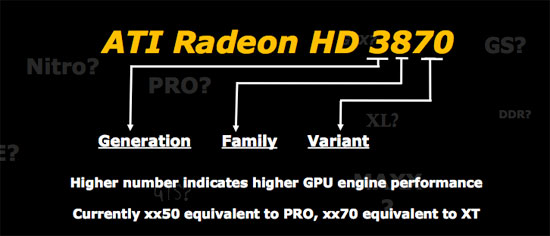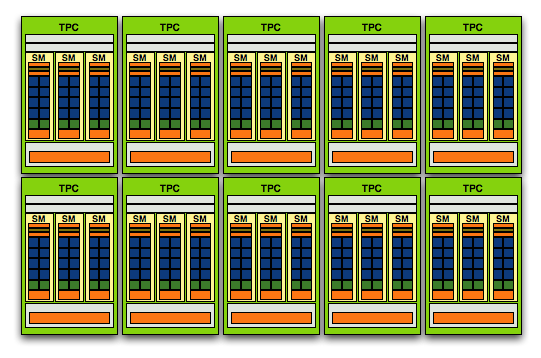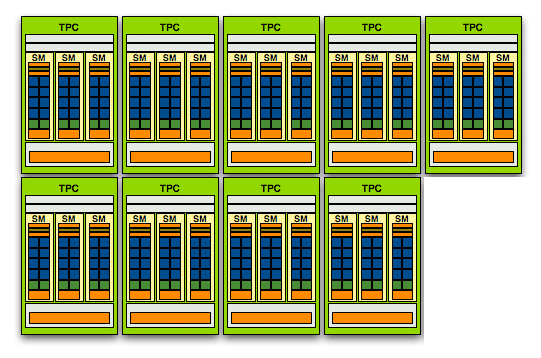NVIDIA GeForce GTX 260 Core 216: Competition for the 4870
by Anand Lal Shimpi & Derek Wilson on September 16, 2008 12:00 AM EST- Posted in
- GPUs
Nearly a year ago I wrote about something I called "sensible naming" with respect to GPUs. It was at the time of the Radeon HD 3800 series launch where AMD unveiled a much cleaner, simpler way of naming its cards. Gone were the suffixes (for the most part) and instead what we were left with was this:

A family name, Radeon HD, followed by a four digit number. With the exception of the X2s, AMD has stuck to its naming system without fault. In fact, AMD has done such a good job with keeping the names clean that things are the way they should be: the internal codenames are more difficult to remember than the actual names of the cards (e.g. RV770 vs. Radeon HD 4870).
NVIDIA however, just hasn't gotten the hint. The GT200 launch gave us two simply named cards: the GeForce GTX 280 and GTX 260, but it didn't take long for NVIDIA to confuse the marketplace with the launch of the GeForce 9800 GTX+. I hoped that the naming silliness was limited to the older GeForce 9 GPUs, but today it extended into the GTX lineup.
It's called the GeForce GTX 260 Core 216.

Holy nomenclature Batman
The GeForce GTX 260 Core 216's name is actually quite descriptive, albeit absurdly long. The GeForce GTX 260 part we already know from the GT200 launch, the Core 216 suffix just indicates that the GPU has 216 "cores" (also playing on Intel's new Core i7 naming for Nehalem, due out later this year). Why NVIDIA didn't just call it a GeForce GTX 265 or 270 is beyond me. To make matters worse, we'll see companies adding their own suffixes to the already extended name. For example, EVGA sent us their Core 216 called the EVGA GeForce GTX 260 Core 216 Superclocked Edition. Perhaps it's some conspiracy to increase the salary of writers who get paid by the word.
| GTX 280 | GTX 260 Core 216 | GTX 260 | 9800 GTX+ | 9800 GT | |
| Stream Processors | 240 | 216 | 192 | 128 | 112 |
| Texture Address / Filtering | 80 / 80 | 72/72 | 64 / 64 | 64 / 64 | 56 / 56 |
| ROPs | 32 | 28 | 28 | 16 | 16 |
| Core Clock | 602MHz | 576MHz | 576MHz | 738MHz | 600MHz |
| Shader Clock | 1296MHz | 1242MHz | 1242MHz | 1836MHz | 1500MHz |
| Memory Clock | 1107MHz | 999MHz | 999MHz | 1100MHz | 900MHz |
| Memory Bus Width | 512-bit | 448-bit | 448-bit | 256-bit | 256-bit |
| Frame Buffer | 1GB | 896MB | 896MB | 512MB | 512MB |
| Transistor Count | 1.4B | 1.4B | 1.4B | 754M | 754M |
| Manufacturing Process | TSMC 65nm | TSMC 65nm | TSMC 65nm | TSMC 55nm | TSMC 55nm |
| Price Point | $420 - $500 | $279 | $250 - $300 | $200 | $130 - $170 |
If you remember the diagram below from our GT200 review you'll see that a GeForce GTX 280 has ten clusters of 24 stream processors (the little blue blocks), for a total of 240 SPs or "cores". The GeForce GTX 260 has eight of those clusters (called Texture/Processor Clusters or TPCs), bringing its total up to 192 SPs. The Core 216, as you can guess, has nine clusters or 216 SPs. NVIDIA just enabled another TPC on the Core 216 (or alternatively, disabled a TPC on a GTX 280).

The GeForce GTX 280, 10 TPCs, 240 SPs

The GeForce GTX 260 Core 216, 9 TPCs, 216 SPs

The GeForce GTX 260, 8 TPCs, 192 SPs
The extra TPC also gives the Core 216 another 8 texture address and filtering units, but the rest of the chip's makeup remains the same, even down to the clock speeds. The Core 216 runs its core, shader and memory clocks at the same frequencies as the vanilla GTX 260.
Priced at $279, the Core 216 is a direct competitor to AMD's Radeon HD 4870 - selling at a similar price. The GTX 260 will continue to exist although selling at a cheaper price point and naturally with more processing power, the GTX 280 remains unaffected.










65 Comments
View All Comments
AnnonymousCoward - Wednesday, September 17, 2008 - link
> 2560X1600 (which I may ask why? since these are not high-end parts?!?)Uhh yeah they are...the 216 is only the second-fastest card in the world. Plus, that ultra high resolution can help expose things like memory size, memory bandwidth, and less CPU influence.
helldrell666 - Friday, September 19, 2008 - link
The new 216gtx is obviously slower than the 4870.It loses against the 4870 in 4 out 0f 6 games at 2560 res. and 5 out of 6 games at 1920 res.At 2560 res. they should've used the 4870 with 1 GB version.
AnnonymousCoward - Saturday, September 20, 2008 - link
Looking at all the bar graphs in this review, the 216 beats the 4870 6 out of 10 times.strikeback03 - Wednesday, September 17, 2008 - link
Because the difference between 96.8 and 111.2 is rather irrelevant? Both cards can rock those resolutions, so the difference might lise elsewhere in the test systems. Since they aren't reporting minimum frame rates, both of the above are well into the playable range.7Enigma - Friday, September 19, 2008 - link
Not to me it isn't. Those numbers today can be 1/2 tomorrow with the latest game. I'd love to see the % of people purchasing these cards with a monitor capable of the highest resolution benchmarked. I think 1% is a safe bet. That 1% benefits from the game summary while the remaining 99% of potential buyers with lower res monitors that fail to read the broken-line graph and instead just read the game summary are given bad/incomplete information.Trust me, I'm not saying Anand is conspiring to put the Nvidia card in a better light, just that the summary as it stands is very misleading.
Jedi2155 - Wednesday, September 17, 2008 - link
Or maybe it is the lack of memory in the frame buffer for the 4870 that prevents it from scaling its performance all the way to 2560.I believe it is a very important fact that the 4870 is faster at the lower resolutions than the Core 216, this omission shows a lack of attention to detail on the summary :-/.
Jedi2155 - Wednesday, September 17, 2008 - link
Or maybe it is the lack of memory in the frame buffer for the 4870 that prevents it from scaling its performance all the way to 2560.I believe it is a very important fact that the 4870 is faster at the lower resolutions than the Core 216, this omission shows a lack of attention to detail on the summary :-/.
Stupido - Wednesday, September 17, 2008 - link
Few days ago I got my new 24'' monitor... So I'm curious and would like to know your opinion:Currently I own Asus 8800GTS 512 but want to move to Sapphire HD4780 1G... Is it worth doing so?
P.S.
I have Vista machine and mainly (90% of the time) is for gaming (TF2, COD4 & Crysis. But planning to buy FarCry2 and Crysis Warhead?)... It is a Q6600@2.4GHz (planning to OC) on Gigabyte P35-DS3R with 4GB DDR2-800.
AnnonymousCoward - Wednesday, September 17, 2008 - link
GT200 gives very poor performance! It has double the transistors of the previous generation for marginal gains. The GX2, with the same total transistors as GT200, blows it away.Since the Geforce 256, every new series has basically doubled performance, but this trend stopped from 8 to 9, and again 9 to GT200. The 8800 GTX is nearly 2 years old, and is still in the same league.
CollectorZ - Wednesday, September 17, 2008 - link
Perhaps if Nvidia spent a little less money on marketing defective 280s and got on with the 55nm parts....Post exam October 25 would be a nice time to replace my 8800GT....